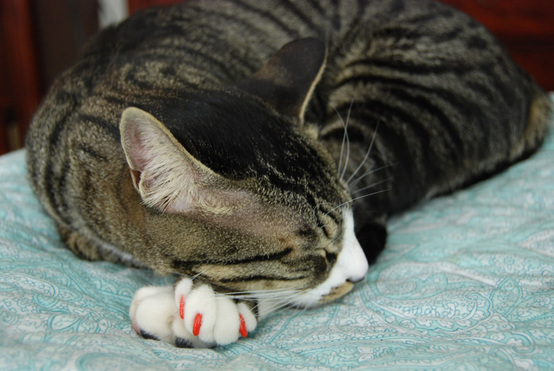|
When it comes to Tigger and his inappropriate scratching at the side of the couch or on the back of a favorite recliner, only in America does the word “declaw” come to mind. In most European countries, this procedure is considered “inhumane” and an “unnecessary mutilation” … in which it should be viewed. Declawing a cat is not a simple manicure, but the amputation of the last joint of a cat’s toe; in order to remove the claw, the bone must be cut. It’s equivalent to cutting off the first joint of a human finger. Ouch! This is a serious surgery with a painful recovery. And remember, the cat still has to walk on his paws, jump, and scratch in the litter box while experiencing this pain.
Claws are an important part of the cat’s design. Not only are they used for hunting, but also for exercise and marking territory. Cats scratch to help them exercise and stretch muscles, and to aid with grooming; scratching removes old nail sheaths. Cats also scratch to communicate their presence, by leaving both physical and scent marks. Cats have scent glands between their toes that leave pheromones behind to communicate with other animals. Additionally, cats use their claws to express emotion – when Morris scratches at your leg around dinner time with increased excitement – and for defense if threatened. Declawing a cat has no health benefits and comes with lots of potential and serious complications. Post-surgical problems:
Long-term, chronic conditions:
In addition to serious health problems, many cats who have been declawed suffer from psychological trauma that manifests as negative behavioral changes.
As anyone can see, declawing a cat is a drastic and cruel response to protecting furniture. The good news is there’s plenty of humane solutions to prevent Tigger from tearing up the couch.
Keep in mind, nail trimming and Soft Paws should only be used on indoor cats; if cats are permitted to go outside, they will need their claws for defense. In 2002, West Hollywood, California became the first U.S. city to ban declawing, with Los Angeles, San Francisco, Burbank, Santa Monica, Berkeley, Beverly Hills and Culver City all following suit in making declawing illegal. Later in 2012, California became the first state prohibiting landlords from requiring tenants to declaw or devocalize their animals, with Rhode Island following suit in 2014. And in January of 2015, a law was introduced that would make New York the first state to ban declawing; the bill is awaiting a committee hearing. For more information on declaw legislation visit (ThePawProject.org). Photo Credits: SoftPawsWiki photo: myllissa from Seoul, S. Korea (Red Nails Uploaded by Caspian blue) [CC BY-SA 2.0 (http://creativecommons.org/licenses/by-sa/2.0)], via Wikimedia Commons DeclawWiki photo: Turn685 (Own work Turn685) [CC BY 3.0 (http://creativecommons.org/licenses/by/3.0)], via Wikimedia Commons
3 Comments
Lara McGowan
5/7/2020 02:25:37 pm
I would love to volunteer to help stop this terrible procedure! Please let me know how I can help in Northern California!
Reply
10/12/2022 01:26:40 am
Here on your blog the recommendations about cat health are quite tremendous thanks for the excellent sharing. I hope after getting the problem solution about pets would be trusted. I really like your valuable sharing please continue to bring further help.
Reply
7/26/2023 08:20:39 am
The refinishing of the floor has been done for the new look for the turf. Elements of the floor refinishing are implied for the rats. The change is done for the approval of the joyful end and mans for the terms. Style of the refinishing is done for the attachment for the terms for the citizens.
Reply
Leave a Reply. |
Details
AuthorAlley Cat Rescue is leading in the way in promoting humane and compassionate care for ALL cats. Archives
April 2024
Categories
All
|

 RSS Feed
RSS Feed